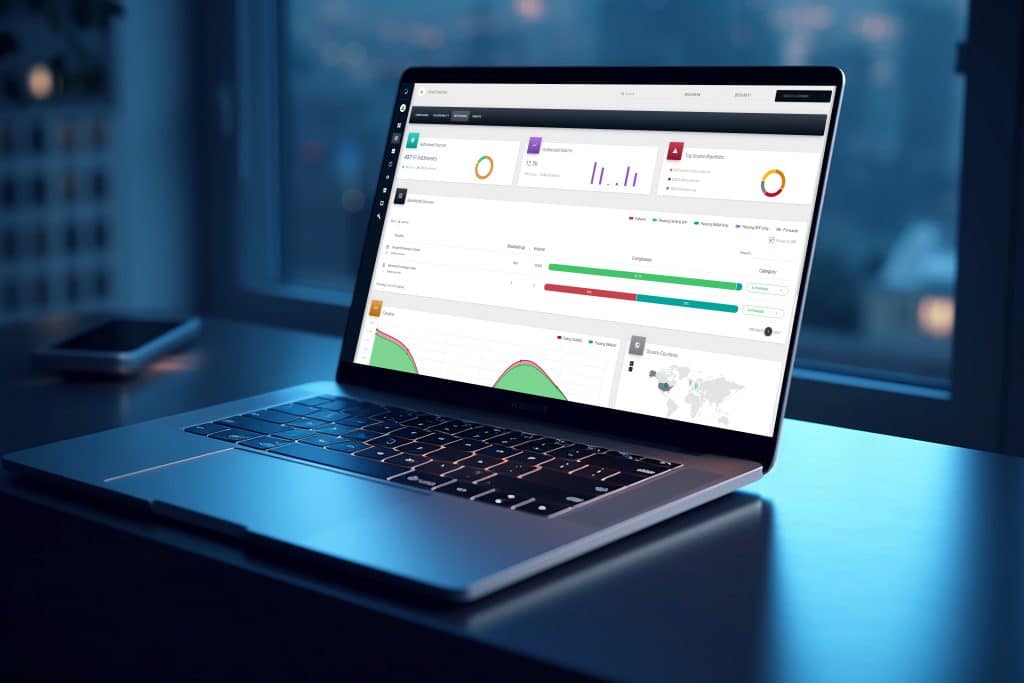Blog article
- 8 minutes read

- Melissa Collins
- Senior Digital Copywriter
Maximizing DMARC reporting: an IT professional’s email security gamechanger
Among its other benefits, DMARC can provide domain owners with invaluable reports containing data that can be leveraged to fortify email ecosystems against cyberthreats.

Since 2015, DMARC has protected major brands like Bank of America, LinkedIn, and PayPal from cybercriminals.
At its core, Domain-based Authentication, Reporting, and Conformance (DMARC) is a robust global email security standard that authenticates the email sender’s domain and helps to identify and after fully implemented prevent fraudulent, email-based attacks like spoofing and phishing scams – the latter of which accounts for 70% of all cyberattacks. DMARC ultimately helps to reinforce brand trust and protect businesses from the potential financial and reputational damage caused by such malicious activity.
A vital part of how DMARC helps businesses achieve this is through the reports it provides. Once enabled on a domain, DMARC enables receivers of your email to generate detailed Aggregate and Forensic Reports – we’ll explain these in detail a bit later – that contain all the necessary information for the domain owner to ensure that their domain is safe from impersonation.
Did you know that around 3.4 billion malicious emails are sent daily?
The fact stands true: no organization is exempt from being targeted by cybercriminals. Without a certified, compliant, and tested DMARC reporting platform from an industry expert, a business is a sitting duck to email fraudsters.
So, what’s the difference between managing DMARC reports yourself, or leveraging a DMARC reporting platform? Let’s take a look.
DMARC reports vs. DMARC reporting platforms: which has the upper hand on email impersonation?
- Reports delivered from email service providers arrive as raw XML files, which you’ll need to decode yourself.
- You’ll need to input sender domains one by one into an IP tool to gather more information about each sender.
- You’ll receive reports from various email service providers and have to collate the data they provide manually.
- You will need to have a dedicated resource in your team constantly reviewing and performing the above actions, which is very time consuming.
For businesses, gaining the upper hand on cybercrime begins with visibility into email environments and potential threats, which is why a dedicated DMARC reporting platform is a must for any IT team looking to maximize DMARC reporting.
Here are a few of the benefits to look forward to once your domain is DMARC-compliant and you’re using a management tool for reporting:
- Early threat detection
Through the comprehensive insights provided by DMARC reports, your business can get a granular understanding of email authentication performance and potential vulnerabilities in a domain’s communication channels. This detailed reporting facilitates the identification of trends, patterns, and anomalies in email traffic, empowering your organization to proactively address emerging threats before they escalate, and ultimately improves overall cybersecurity readiness. - Enhanced visibility and control
Using a DMARC reporting tool provides a comprehensive view of email traffic originating from your business’s domains, helping to proactively monitor email flows and quickly detect and mitigate phishing attempts or unauthorized email activity. - Increased deliverability
DMARC reporting tools can assist in the refinement of email filtering and authentication mechanisms. By analyzing DMARC reports, your business can identify legitimate emails sent from your domain that failed DMARC checks due to misconfigurations or system inconsistencies. This reduces false positive rates and minimizes the risk of legitimate Business, Sales or Marketing emails landing in the recipient’s junk or spam folder.
The Anti-Phishing Working Group’s (APWG) Phishing Activity Trends Report highlights DMARC’s positive contribution to mitigating phishing attacks, emphasizing that businesses aiming to bolster email authentication practices and combat email-based threats must prioritize accessing and understanding DMARC reporting.

DMARC reports explained
To begin DMARC implementation, you need to understand DMARC’s reporting process, which follows a three-step checklist:
- Access
- Differentiate
- Analyze
Let’s have a look at these steps in a bit more detail
1. Access
To access DMARC reports, an organization must publish a DMARC record in its Domain Name System (DNS). This published DMARC record specifies what happens to emails that fail DMARC authentication when they reach a recipient’s server, domain reporting requirements, and the email addresses to which DMARC reports should be delivered. Once the DMARC record is published, the email recipient’s server will generate and send DMARC reports to the specified email addresses.
2. Differentiate
There are two types of DMARC reports: Aggregate (RUA) Reports and Forensic (RUF) Reports. Understanding the difference between these report types is critical to interpreting reporting data and using it to your business’s advantage.
Some of the downfalls of managing DMARC reporting independently include:
- Aggregate (RUA) Reports: An Aggregate Report is a comprehensive overview of email authentication data collected from various sources. It provides a consolidated view of email traffic, outlining the number of emails sent, the domains sending those emails, and each email’s authentication status. These reports are typically sent on a daily or weekly basis and are valuable for monitoring email authentication trends and identifying potential issues.
- Forensic (RUF) Reports: A Forensic Report provides detailed information about individual emails that fail DMARC authentication, including email headers, body, and authentication results. Forensic Reports are sent in real-time or near-real-time and provide comprehensive data to assist in incident investigation.
3. Analyze
The key elements to focus on when analyzing Aggregate Reports are:
- Alignment: DMARC uses two authentication protocols called the Sender Policy Framework (SPF) and DKIM (DomainKeys Identified Mail) to verify domain-alignment. Proper alignment demonstrates that the sender’s domain (or commonly called the Return path or SMTP From Address) matches the domain in the “From” header of the email.
- Policy actions: Pay attention to how email recipients’ servers are treating emails that fail DMARC authentication. This can help you understand if your DMARC policy is being enforced correctly.
Key areas to focus on when analyzing Forensic Reports include:
- Authentication results: Look for failed SPF or DKIM results, as these indicate potential spoofing attempts, email interception, message forwarding or configuration issues.
- Headers and metadata: Examine email headers to identify source IP addresses, message routing, and any modifications made during transit.
- Attachments and URLs: Evaluate attachments and embedded links for any suspicious or malicious content if provided by reporters.
- Sources: Identify which IP addresses or servers are sending emails on behalf of your domain. Check for any unauthorized, unexpected or suspicious international sources where your business does not transact from.
Benefits of leveraging Sendmarc’s DMARC reporting platform

Securing your email: Best practices for business defense in 2024 and beyond
Sendmarc provides a secret weapon for IT professionals looking to quickly increase email security, in an easy, seamless, and powerful way.
When leading industrial group Bidvest made the move to implement DMARC with Sendmarc it reaped massive positive results. To mention a few; the company gained full visibility of its entire email environment (active and inactive domains) and its environments were secured and protected with the highest DMARC compliance standard (p=reject) within 90 days. By being DMARC compliant the Bidvest Group is protected from financial and reputational damages caused by email fraud.
Sendmarc’s DMARC platform will empower you to effectively monitor and secure your business’s email ecosystem while saving time and resources in the following ways:
- Centralized management: You’ll have all reporting data at your fingertips, in one place instead of receiving individual reports from various email service providers.
- Automated data processing: Our DMARC reporting platform gathers and enriches data to easily present you with the knowledge of what to do next, saving you the time and effort of deciphering next steps from individual reports.
- Alerts and notifications: You’ll receive automated alerts based on specific DMARC events, helping you to identify and respond to potential security threats faster.
- Historical data and trend analysis: Historical data is stored on the platform, allowing you to track trends and patterns over time. This keeps you aware of any changes in email delivery, authentication failures, or potential abuse of your domain.
- Actionable insights: Sendmarc’s DMARC reporting tools provide valuable insights into your email ecosystem. They help identify senders using your domain, who their email service provider is, and even where they are in the world. Once you know if any unauthorized senders are using your domain, you can take the next steps to stop them.
Organizations that leverage DMARC reporting tools, like Sendmarc, can effectively prevent email impersonation, maintain brand trust and reputation, and safeguard stakeholders from email-based cyberattacks, ultimately protecting their business and bottom line.
What if you could leverage an intelligently designed DMARC platform, with outsourced and ongoing monitoring services and easily accessible advice from a team of DMARC experts? You can.
At Sendmarc, we’ve made it our mission to master the intricacies of effective with as easy-as-possible DMARC implementation and reporting.
Get in touch with us today to find out how we can help you win security and profit by maximizing DMARC reporting with a dedicated DMARC reporting platform.